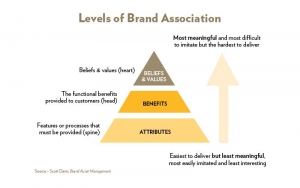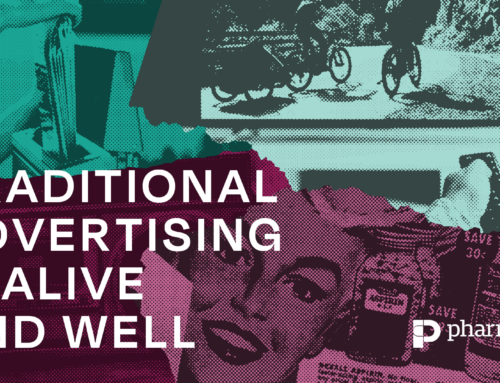The following is an excerpt from
Healthcare Tsunami, The Wave that Will Change US Business
By Dean Halverson & Wayne Glowac
Smart business people have embraced the concept of branding since commerce began thousands of years ago. Within the past 2 decades, the concept of branding has become trendy. It is common to pick up any business publication and find the word brand or branding liberally used, often with contradictory meanings. Although the attention paid to the concept of branding has been positive, the misuse of the term has created confusion. In this whitepaper, we will explain the basic foundations of branding and how a company can maximize its marketing to attract new customers while building bullet-proof customer loyalty.
A brand is not a logo or an ad. Branding is not creating a new name or identity. A brand (noun) is a tangible product or service and the emotional feelings that are associated with the product. Branding (verb) is carefully crafting what you offer and managing the feelings and expectations of your customers.
Many cognitive scientists believe that up to 95% of all behavior is unconscious. Emotions have far more impact on our decision making process than logic alone. It isn’t, and never was, just about building a better mousetrap. If we made our purchases based upon logic and material value alone, the world would be a very different place.
The value of understanding and managing a brand are numerous. Companies that manage their brand not only have greater positive word-of-mouth advertising, they enjoy greater customer loyalty and higher profitability. The return on branding is not just about generating positive feelings; the payoff is something that can be taken to the bank.
Before we review the principals of branding, it is important to understand a few key definitions.
Marketing: The total process of imagining, planning and implementing business activities intended to bring together buyers and sellers for the mutually advantageous exchange of products or services.
Brand: (noun) A product or service and the sum total of feelings and expectations of the marketplace for any product or service.
Branding: (verb) Managing the brand for maximum loyalty and profitability.
Advertising: Paid communications (media and creative) designed to influence a specific target audience.
Public Relations: The relationship between an organization and its various “publics” and its effort toward influencing positive publicity and awareness.
Sales: The process of preparing and interacting with current and prospective customers to facilitate the immediate transfer of goods and/or services.
Branding begins with attitude. As healthcare consumerism grows, it will require a shift in how consumers think about and engage in healthcare consumption. It will also require a shift in the basic philosophy of many business leaders some of whom seem to be in denial that any change will occur. Many consumers, providers and insurers are uncomfortable with this power shift. Education will be key in selling across marketing channels, reducing anxiety and creating adoption.
Branding is strategic thinking. If a company is not focused on its basic vision, it is not maximizing its resources. There are two basic strategic components to branding. The first is brand vision. The vision of any organization is the reason it exists and is the passion that drives its people to succeed. Although a vision must include a value proposition for the customer, it should also include a higher purpose. That purpose has been, or should be, defined by the founders and/or leaders of the organization. That vision is a private statement of purpose and should drive all major business decisions.
The other strategic component of branding is brand position. If vision is the internal driving force, then positioning is the external driving force. It is how a company wants to be seen and valued by its customers. The brand position is a public face. It relates directly to the vision and comprises a statement of value for customers.
One way to consider any business model and the interplay of features and emotions is through the Levels of Brand Associations. The foundation of any product or service is the features or processes that it provides. These represent the day-to-day deliverables of the product or service; they must be delivered to provide value. Features or attributes represent the component of a product or service that is easiest to deliver and to be imitated or copied by any competitor. Attributes make up the majority of advertising messages, but in reality are the least meaningful to the consumer.
Of greater importance to the consumer are the benefits offered by any exchange. These represent the functional or emotional benefits being provided by a product or service.
At the top of the Levels of Brand Associations are beliefs and values. These represent the emotional, cultural and spiritual values that are provided when you buy a product or service from any company. These values are the most meaningful to consumers and are the hardest to imitate.
Quick, what do you think if when you read the word Volvo? Most people will respond “safety.” Over the years, Volvo has worked very hard to own the value of safety. On the bottom of Volvo’s Levels of Brand Associations is their vehicles and dealer network. They include the cars themselves and their features. At the benefit level Volvo offers improved personal protection and protection for your family should you be involved in an accident. At the top of Volvo’s Level of Brand Associations is safety.
When communicated, beliefs and values are engaging to a level that cannot be compared to promoting the attributes or benefits of any product. One of Volvo’s recent campaigns is “Who Would You Give a Volvo To?” This is a great example of positioning to the emotional values of a product. Volvo is not selling the attributes of their vehicles, they are selling the fact that if you care about your family, and you want to keep them safe, you will drive a Volvo. This is a very powerful message.
The lifeblood of any company is its current customers. It takes 7 to 10 times as much investment to get a new customer as it does to keep a current one. The cost for new customer, or patient, acquisition is even more expensive. As the first step in any branding process we first recommend shoring up the relationship a company has with its existing customers. We ask a series of important operational questions. Do you have a method of customer feedback? Are you aware of any issues your customers have with you? What are your customer touch-points and are you working toward a positive experience in every customer encounter? Do you understand how your customers judge value? Are you driving positive word of mouth? What are the inherent brand promises you make and are you fulfilling them? Who are your competitors and what value do they offer? The answers to these questions point to solid tactical implications necessary to bolster customer relationships.
As women continue to evolve as the primary decision makers regarding their family’s healthcare it becomes more important than ever to understand their needs and wants. As reported in Fast Company (Nov. 2003), women control or influence more than 80% of purchases in the U.S., a total of about $3.5 trillion every year. As discussed earlier, much of the decision-making criterion are based upon emotional characteristics such as relationships and what the service does for them personally and for their family. In general, lists or statistics alone will not motivate this market to action. Careful and considered attention must be devoted to the real motivating factors that will cause women to respond.
A key component to successful branding will involve mass customization. According to Wikipedia, mass customization is “a business technique that allows any customer to buy a product or service that has been pre-designed (customized) to fit a customers exact needs.” In short, mass customization provides the efficiency of mass production with the uniqueness of customization.
In a marketplace of adequate supply and consumer choice, understanding and delivering a mass customized service or product is vital. As we all face increased demands on our time and other resources we will look toward solutions that cater to us as individuals while respecting our time and providing value. As consumers become free to choose where and when they will receive their care, they will base their choices on providers that focus on them.
65 and Over Consumers: This group would be considered the primary users of health services. They are also generally on government coverage with some form of supplemental insurance for their coverage. That means the group is less likely to be a part of the consumerism movement but will be impacted by it dependent upon the action taken by government in the process. Their health needs tend to be more significant and Medicare coverage generally gives them more flexibility and choice in the providers and services they use.
This group is currently being marketed to through traditional channels in print and media. The messages are generally that of quality, advanced technology, availability of specialists and strong outcomes. This group is a more traditional patient and they evaluate the system based on years of experience. They have a long-standing relationship with their primary care physician that is probably over 15 years in length. They trust this physician and rely on their relationship to guide them through the needed services.
This group is not likely to change doctors unless forced. They have high levels of satisfaction and would generally be using the same network and facilities they have used for the past five to ten years. While they are relatively easy to contact and reach they are challenging to influence or change behavior with. This is due to a strong base of personal experience. To successfully change selection behavior with this group a marketer must find access points that might be outside of their primary relationships and experience. This might be things like health screenings or educations programs that can help them improve their health and quality of life.
While this group is less concerned about cost in their decision making we believe they can still be motivated by a message of value. They are generally no longer working and may be working to extend their resources. They will be concerned about outcomes and the personal care they receive during the process. They generally want to develop long-term relationships with providers they feel care about their needs and value their business.
35 to 65 Year Old Consumers: This is a mid-range group that will share characteristics of their younger and older counterparts. They will generally be on some type of commercial insurance plan whether provided by an employer or purchased individually. The younger members of this group may be on HSA’s and HDHP’s and will demonstrate consumerism tendencies. They will become educated and will work to understand how to make better healthcare decisions. Even some of the older members of the group may be on such plans because employers have forced them to adopt such plans if they wanted to continue coverage.
The older members of this group may decide that they are close enough to Medicare age that they do not have to learn to be a good consumer. They may coast through the final years to age 65 and will behave much as they always did. They too have long standing relationships with a primary care physician and will likely rely on their recommendations for the use of services and access to specialists. Because they are still likely to be working changes in coverage may force them to evaluate their relationships and may be forced to change physicians if their coverage requires it. Those with financials resources may choose to keep long-standing relationships and will pay higher out-of-pocket cost to do so.
This group has moderate experience with the healthcare delivery system. They have gained experience from contact in both their care and that of their children. Children are growing up and some are again empty nesters. They have disposable income and should represent a sound opportunity for marketers in all related categories. They will be planning both their financial and health related futures and may be receptive of coverage for long term care. Prevention and wellness is likely to be another opportunity as the group comes to understand that their use of health services is likely to increase. Living healthy could be a key message as it will address their financial and physical quality of life in the future.
This is a mixed group from a media standpoint and will contain opportunities from both their younger and older counterparts. They are likely still users of much of the traditional media, including newspapers and magazines. They are also likely to be web-savvy and will use online tools in the management of their health and the gathering of needed information. They may not be a part of online communities, but can be reached through online tools and resources. Creating portals with information of value to them could be a way to attract this group.
Under 35 Consumers: This group is going to be the most unique of those in the new healthcare. Our existing research in several industries has documented that this groups is more challenging than their older counterparts. We find they have very brand oriented. They seek out national and regional brands and identify with them more so than local or small operations. This appears to be based on a desire to have a consistent experience wherever they would go. Mobility is a factor in this attitude and they tend to travel more and change both jobs and residences more often. The interesting component with the group is that they are actually less brand loyal than the older demographics.
This under 35 consumers will play an important role in the future of healthcare delivery and the success of a variety of new ventures that will be spawned after the tsunami hits U.S. business. They are already having serious impact on traditional providers and their services. They are the dominant users of walk-in services and are leading the drive in retail clinics. This is even stronger if there are children in the household.
As this younger population experiences the new healthcare they are likely to talk to others about it. This will assist the change process by promoting positive experience with new alternatives. Also remember that this group is likely to be caring for older relatives at some point in their lives and will likely use services they prefer and have experience with.
The under 35 population appears to offer the greatest opportunity for providers. They have a lower percentage of existing relationships. They are also most likely to be driven by convenience. While this is group represents a significant opportunity they may be the most challenging of the three groups to reach and influence. They tend to not follow traditional media in the same way as the older population. The generally read less in printed materials. They do not listen to traditional radio, choosing to use satellite radio or iPods to target their specific interests.
The group is more receptive of the others to online communications but their use may be different than their slightly older counterparts. While the use the web to search for information, it is much more engrained in their everyday lives. They are likely to be part of online communities and use blogs to get the type of information they are interested in. They are computer savvy and their children will be as well and this creates new marketing opportunities that are outside traditional mass media used in healthcare. Viral marketing can be an effective tool in reaching this group.
The change in the perspective of the consumer as it relates to healthcare is going to open a whole new arena of marketing opportunities for providers, retailers, financial institutions and anyone who wants to work to attract dollars from the consumer. Healthcare marketing has always had a unique perspective in that they generally did not have to address issues like price, cost or value in their marketing. The industry generally sought to market the high quality care they provided in a number of different settings. In the early days of healthcare marketing this was effective as there were generally notable differences in the quality of care between some providers.
ON YOUR JOURNEY
To help you begin to better understand and manage your brand, here are a few exercises you may wish to conduct with you key staff. Although we recommend you invest in professional help in the form of a marketing consultant and a professional copywriter, we recognize that not all companies have the resources to hire outside support. In any case, these exercises will help you align your staff and help you understand the vital nuances along your brand development journey.
For each of these exercises we have including the format with examples for you to review. Please remember these exercises are not advertising and you may use very little of the words you use in your marketing. These exercises will help you draft the blueprint of how you speak to your suspects, prospects and customers or patients.
POSITIONING STATEMENT
The sentence that expresses how you wish your service to be perceived:
FOR
(target)
YOU ARE THE
(competitive set)
THAT
(delivers this benefit)
Example: For affluent, sophisticated travelers, the Cayman Islands is a warm weather vacation experience that provides the ultimate in relaxation.
Objective
The desired movement in consumer attitude that will result in a desired action.
Objective Statement
The single-sentence, post-discovery summary of the charge.
ADVERTISING WILL
(verb) (target consumer)
TO/THAT
(brand/product/service)
IS/WILL/PROVIDES
(benefit)
BECAUSE
(support/reasons why)
Example: “Advertising will convince automatic dishwasher users that Cascade provides virtually spotless results because of our unique sheeting action.”
BRAND PERSONALITY
How we will relate to our customers. How we say what we say.
5 words that describe our personality.
BRAND PARTITIONING
Attribute: An inherent or natural characteristic of a product or service
(The iPod is a small, portable MP3 player)
Feature: A manufactured or designed aspect of the product
(It holds an incredible amount of music in one place)
Product Benefit: The benefit to the user based on the product
(Your favorite music is easy to take with you)
Consumer Benefit:
The positive result to the consumer
(Full access to your music library – anytime, anywhere)
Value: The human dimension reinforced by the benefit. How the benefit within the product or service manifests itself within the consumer. (I’m cool because I’m part of the iPod culture and can carry a large part of what makes me ‘me’ wherever I go. It’s the soundtrack to my life.”)
Whether you think about it or not, your pharmacy is a brand — and your brand has a story to tell. At Pharm Fresh, we never miss an opportunity to help you promote your brand and story. We can help you improve your pharmacy’s brand with great design, the smartest marketing techniques, and high quality materials. Call us today at 877.327.4276 to get started on your story.






